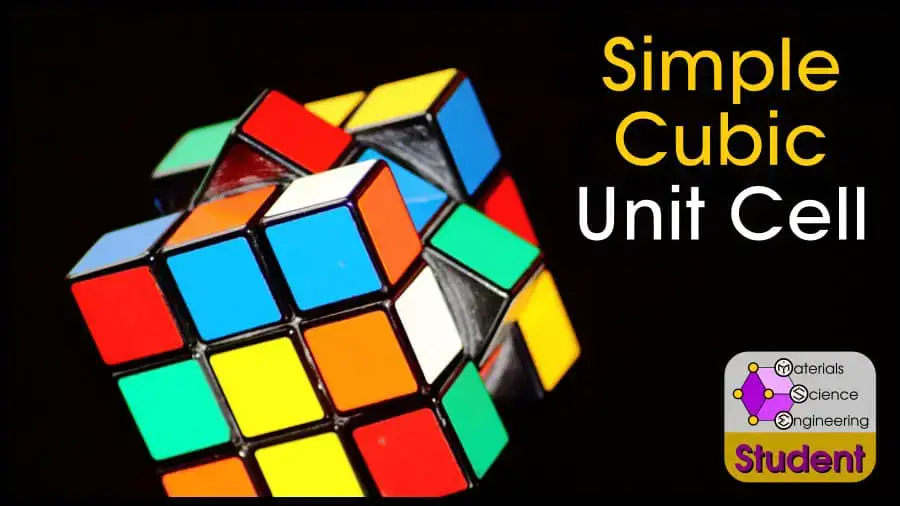Simple Cubic Unit Cell

The simplest unit cell is Simple Cubic (SC). This crystal structure is just a cube with an atom on each corner. The simple cubic unit cell may also be called “primitive cubic” and thus abbreviated as cP. The simple cubic unit cell belongs to space group #221 or , Strukturbericht Ah, and Pearson symbol cP1. αPo is the prototype for SC.
The simple cubic (SC) unit cell can be imagined as a cube with an atom on each corner. This unit cell is the simplest for people to understand, although it rarely occurs in nature due to its low packing. SC has 1 atom per unit cell, lattice constant a = 2r, Coordination Number CN = 6, and atomic packing factor APF = 52%.
Don’t worry, I’ll explain what those numbers mean and why they’re important later in the article. For now, let’s talk about which materials actually exist as simple cubic.
Outline
Common Examples of Simple Cubic Materials
Haha, actually there are no “common” materials with a simple cubic structure. The only element that displays SC at regular temperature and pressure is the rare, extremely radioactive Polonium (α-Po).
This is because SC has a low coordination number and low packing factor. That means it is not a very stable structure.
Phosphorus, antimony, and some tellurium-based materials may also have a simple cubic crystal structure in the right circumstances.
Simple Cubic Coordination Number
Coordination Number (CN) is the number of nearest neighbors that each atom has.
In a simple cubic crystal, each atom has 6 nearest neighbors. That’s half as many nearest-neighbors as close-packed structures like FCC and HCP. Each nearest neighbor is an atomic bond, so SC’s 6 nearest neighbors imply a weak, unstable structure.
Simple cubic has 12 next-nearest neighbors, and 8 next-next nearest neighbors.
Simple Cubic Lattice Constants
The simple cubic lattice is a cube with an atom on each corner. Using the hard sphere model, which imagines each atom as a discrete sphere, the SC crystal has each atom touch along the edge of the cube.
Since each side of unit cell extends from half of one atom to half of the other, the side of the cube, or lattice constant (represented by ) is just
where
is the radius of the atom.
If you wanted to describe the simple cubic crystal with math, you would describe the cell with the vectors
Because all three vectors are the same length and are at 90º to each other. If you start with one atom, there will be another atom at any combination of these three vectors.
Simple Cubic Atomic Packing Factor
The Atomic Packing Factor (APF) is essentially the density of the unit cell. Since we use the hard sphere model, each point inside the cell is either part of an atom, or part of the void.
APF is basically the fraction of atoms to void. For a full article explaining APF, check out this link.
APF is the
The total volume of the unit cell is just the volume of a cube. The cube side length is a, the volume is .
Now we need to count how many atoms are in each unit cell. It may look like there are 8 atoms because there are 8 corners, but actually the cell only intersects 1/8th of each atom. , so there is one atom per unit cell.
In fact, an equally valid way of drawing a simple cubic unit cell is like this:
But that’s not so useful because it doesn’t show symmetry relationships as well as the traditional model.
The volume of a sphere is . We previously established that the area of the whole cube is
, and since
, the volume of the cube is
.
Now that we’ve written everything in terms of the radius of an atom, you can see that every simple cubic crystal will have the same packing factor regardless of the actual element.
As you can see, simple cubic crystals have 52% packing. Almost half of the solid is empty space! This is another reason why SC is such a rare, unstable crystal structure.
Interstitial Sites in Simple Cubic
Interstitial sites are the spaces inside a crystal where another kind of (smaller) atom could fit. SC only has one interstitial site.
Simple cubic has a single interstitial site in the center. This site is called a cubic interstitial site, since it would have a coordination number of 8. If an atom of the same type were to occupy this space, the crystal structure would change from SC to BCC.
Final Thoughts
The Simple Cubic crystal structure is the simplest 3D structure for humans to understand, which is why you may have learned about it in your first materials science class. However, the structure is unstable and rare, so it has little practical applications.
| Crystal Structure | Simple Cubic (SC) |
| Unit Cell Type | Cubic |
| Relationship Between Cube Edge Length a and the Atomic Radius R | a=2r |
| Close-Packed Structure | No |
| Atomic Packing Factor | 52% |
| Coordination Number | 6 |
| Number of Atoms per Unit Cell | 1 |
| Number of Interstitial Sites | 1 |
| Examples | α-Po |
No comments:
Post a Comment